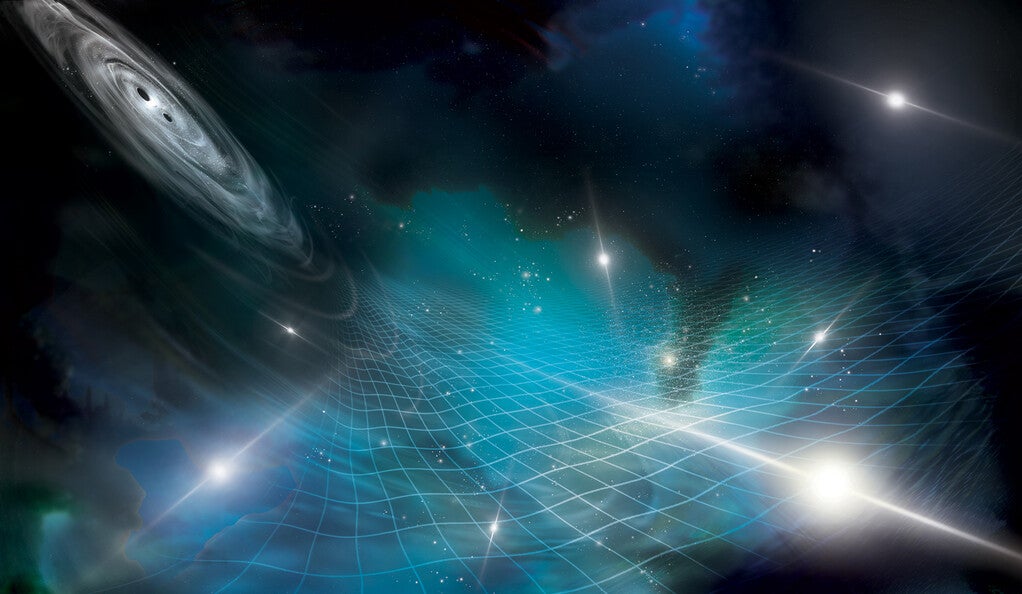Video
Astrophysicists present first evidence of gravitational wave ‘background’

Artist’s interpretation of an array of pulsars being affected by gravitational ripples produced by a supermassive black hole binary in a distant galaxy. (Credit: Aurore Simonnet for the NANOGrav Collaboration)
Researchers have found the first direct evidence of a “background” of gravitational waves in the universe — a sign that gravitational waves from slowly merging pairs of supermassive black holes, or possibly from the early universe, can be detected from Earth in a background field of low-frequency energy.
The discovery, made by the North American Nanohertz Observatory for Gravitational Waves (NANOGrav), helps confirm the accuracy of standard models of galaxy formation and black hole growth.
NANOGrav scientists, including Yale’s Chiara Mingarelli, published the discovery in a quintet of new studies June 29 in The Astrophysical Journal Letters.
“These are big questions we’re trying to answer about how the universe evolved,” said Mingarelli, an assistant professor of physics in Yale’s Faculty of Arts and Sciences. “I’ve been interested in helping to find these answers since I was a kid. It’s awe-inspiring.”
Gravitational waves are ripples in the fabric of space-time, which can be caused by the merging of two black holes. Albert Einstein predicted the existence of gravitational waves in 1915 as part of his general theory of relativity. A century later, scientists at the Laser Interferometer Gravitational-Wave Observatory (LIGO) announced the first observation of gravitational waves.
LIGO scientists, however, were only able to detect waves from the higher frequency end of the gravitational wave spectrum. In order to look for waves at the lower end of the gravitational wave spectrum — such as more distant and powerful waves from supermassive black hole collisions — a different detection method was necessary.
The NANOGrav project, which began in 2007 and includes more than 170 researchers from more than 70 institutions, spearheaded a detection method centered around pulsars.
Pulsars are rapidly rotating neutron stars — the collapsed cores of massive stars that have exploded. Pulsars send out radio emissions that can be timed to the millisecond, making each one something of an ultra-accurate, cosmic clock.
With help from several ground-based telescopes in the United States and Canada, NANOGrav created a network of precisely timed pulsars, which allows NANOGrav researchers to measure and track previously undetected gravitational waves at low frequencies as they make their way to Earth. Gravitational waves, as they wash over the pulsars, alter the distances between the pulsars in the array and the Earth — meaning the normally-stable pulsar signals reach Earth early and then late.
Gravitational waves leave an indelible but challenging-to-detect signal within pulsar timing signals.
The five new studies elucidate the detection of the gravitational wave background field, the data that NANOGrav collected, a characterization of the data, tests of fundamental physics, and an astrophysical interpretation of the data in terms of supermassive black hole physics, respectively.
The findings “open a tantalizing new window — the gravitational wave window — and offer a first glimpse into the population of supermassive black holes,” said Priyamvada Natarajan, the Joseph S. and Sophia S. Fruton Professor of Astronomy and professor of physics in Yale’s Faculty of Arts and Sciences and chair of the Department of Astronomy, who is a co-author of the detection study.
“This is really exciting for those of us who have been building models of the growth and evolution of black hole populations that involve mergers as one key mode by which black holes are expected to grow,” added Natarajan, who is a member of the NANOGrav collaboration.
Mingarelli noted that the findings confirm standard models of how the universe works, particularly in terms of supermassive black holes.
“Up until now all we could see of supermassive black holes have been snapshots in time,” she said. “Directly seeing merging supermassive black holes is almost impossible — their tight orbits mean that they are too close together to see individually, since they are so far away. Now, for the first time, we have evidence that they merge. We don’t need to see them, we can hear them.”
Mingarelli joined the NANOGrav project in 2014 and was previously a member of the European Pulsar Timing Array. Her work has involved simulating gravitational wave backgrounds and interpreting NANOGrav data to understand how gas and stars affect supermassive black hole mergers, in terms of their wave signals. She has also created tools to create maps of the gravitational wave sky, to see where there might be higher concentrations of gravitational wave signals.
Next on NANOGrav’s research agenda, she said, will be to determine whether there are nearby merging supermassive black hole systems that can stand out above the gravitational wave background, and other events in the early universe creating gravitational waves, in addition to black holes.
NANOGrav receives support from the National Science Foundation, the Gordon and Betty Moore Foundation, a National Sciences and Engineering Research Council of Canada (NSERC) Discovery Grant, and the Canadian Institute for Advanced Research.
Media Contact
Michael Greenwood: michael.greenwood@yale.edu, 203-737-5151